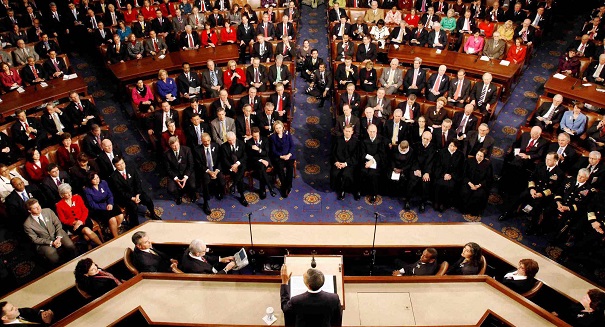
Tradition of State of the Union continues
Although there is no requirement in the U.S. Constitution mandating the January ritual as we now know it – an annual, oral address to a joint session of Congress with specific protocol and attendant hoopla, Article II, which covers the Executive branch, states, “He shall from time to time give Congress information of the State of the Union and recommend to their Consideration such measures as he shall judge necessary and expedient.”
George Washington who as first president had the task of fleshing out his job description from the sometimes vague language of the article, interpreted the directive literally. The first State of the Union address was delivered to Congress in 1790. Thomas Jefferson, ever sensitive to even the appearance of monarchical tendencies in government, abolished the practice submitting a written report, instead.
Tonight, the president will deliver a speech months in the making, the last iteration of the many drafts produced by his team of writers, amid as much pomp and circumstance as is seen in American government. Only on Inauguration Day, or on the occasion of a state funeral is there as much formality in Washington. The Founders could not have imagined that the update on the government would be broadcast live to the American public and around the world, seen on television, heard on the radio and streamed online.
The protocol is set and the evening timed to the minute. The president, like a bride at her wedding, is the only member of the cast who is allowed to be late. Special guests are seated in the First Lady’s Box, a tradition since 1982 when President Reagan honored Lenny Skutnik, the hero who jumped into the frozen Potomac to rescue a plane crash victim. Tonight, Michelle Obama will host 23 guests, including a victim of ebola, an astronaut and a so-called “Dreamer,” a child of immigrants who came to the United States illegally.
Members of Congress – 100 senators and 435 representatives, along with their invited guests, will stand and applaud as the Sgt. at Arms announces the president who will take time as he walks to the well of the House chamber, stopping to shake hands with some members and give a cheek kiss to others.
Once at the imposing podium, the president will give copies of his speech to the Vice-President and Speaker of the House, first and second in the order of succession, who sit behind him. Members of the Supreme Court – rarely all nine, stand in acknowledgement, but rarely applaud. The Cabinet will also be in attendance, with the famous exception of the “designated survivor,” a Cabinet member who remains in a secret location as a safeguard against the possibility of the destruction of the U.S. government by an attack on the Capitol building when every member of the three branches is assembled in one room.
The evening, rich in tradition, is grand theater and uniquely American. Britain’s Prime Minister engages in spirited, often witty, debate in weekly Wednesday sessions at Parliament and as reigning monarch gives a “Speech From the Throne,” usually marking the opening of Parliament. The similarity would horrify Jefferson, but of course, the Queen is beyond partisanship: her role is to provide the theater.
The American president’s speech sets a political course of action, announces proposed legislation, intimates vetoes of bills he opposes, and gives his party a platform. And occasionally, such as when Representative Joe Wilson (R-SC) pointed to President Obama and shouted, “You lie!” as the president explained that the health reform bill would not apply to illegal immigrants, or when Supreme Court Justice Alito took visible, but silent, exception to the president’s assessment of the Court’s decision in the Citizens United case while Justice Ruth Bader Ginsburg dozed off, it makes great television.
Leave a Reply